Marrying Vega and Zen: The AMD Ryzen 5 2400G Review
by Ian Cutress on February 12, 2018 9:00 AM ESTiGPU Gaming Performance
Throughout their history of having fully integrated GPUs, AMD has always favored going for powerful configurations that approach the lower-end of discrete GPU performance. With comparable discrete cards going for $80 or more, a powerful iGPU is a significant value proposition for AMD’s APUs. Furthermore as Intel has continued to stick with relatively lightweight iGPUs for most mainstream SKUs – a trend even the newly released “Coffee Lake” 8th Gen Core family continues – AMD has easily trounced Intel’s iGPU performance.
In fact the most recent 8th Gen Core CPUs generally fail to catch up to AMD’s last-generation 7000/8000 series “Kaveri” APUs, which means that for the launch of AMD’s new Ryzen APUs, the manufacturer is just going to be running up the lead even more. The real question we’ll be looking at on the iGPU side isn’t what’s faster – that’s obvious – but just how many times faster the 2400G & 2200G APUs are over their Intel equivalents, and how they stack up against an entry level discrete video card, the GeForce GT 1030. With upwards of 11 CUs in an APU, on paper the Ryzen APUs should be able to offer 1080p@30fps gaming at maximum (or near-maximum) image quality.
During our pre-briefing, several sets of benchmarks and configurations were 'suggested', focusing on eSports and a mid-range quality setting, to show what the platform can do. For our testing, we used our CPU Gaming 1080p gaming suite. This suite was developed with mid-range and high-end graphics cards in mind, with mostly high or ultra quality settings, pushing beyond what was suggested. The reason we did this was two fold:
- In our data, it shows a sizeable difference between integrated graphics solutions that can offer potential, compared to those that fall at the first hurdle.
- Second, it offers a stark reminder that while for the most part websites and enthusiasts like as way lyrical about high-end performance, the data shows both how far integrated graphics has come, and how far it still has to go to qualify for those 'immerse experiences' that Intel, AMD, and NVIDIA all claim are worth reaching for, with higher resolutions and higher fidelity.
Civilization 6
First up in our CPU gaming tests is Civilization 6. Originally penned by Sid Meier and his team, the Civ series of turn-based strategy games are a cult classic, and many an excuse for an all-nighter trying to get Gandhi to declare war on you due to an integer overflow. Truth be told I never actually played the first version, but every edition from the second to the sixth, including the fourth as voiced by the late Leonard Nimoy, it a game that is easy to pick up, but hard to master.
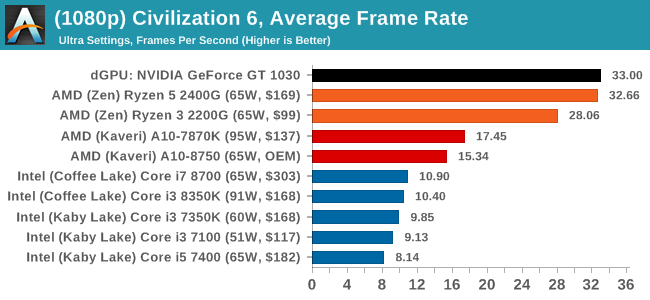

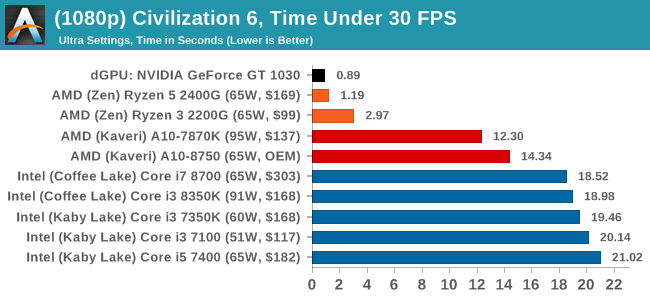
While Civilization is not too limited to frame rates, the APUs straddle the 30FPS average, and the GT 1030 comes out on top just about. Intel's integrated graphics options are only 1/3 of what AMD is providing in this case.
Shadow of Mordor
The next title in our testing is a battle of system performance with the open world action-adventure title, Middle Earth: Shadow of Mordor (SoM for short). Produced by Monolith and using the LithTech Jupiter EX engine and numerous detail add-ons, SoM goes for detail and complexity. The main story itself was written by the same writer as Red Dead Redemption, and it received Zero Punctuation’s Game of The Year in 2014.
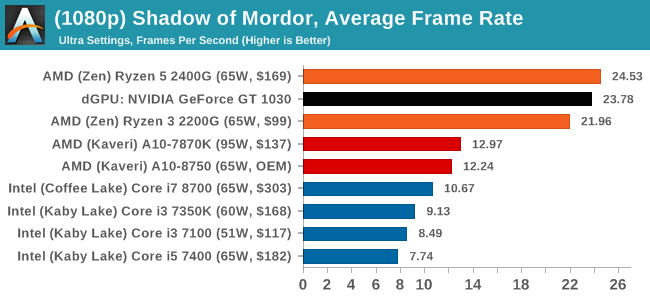
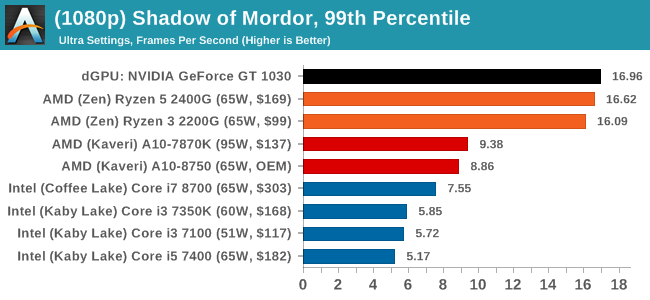
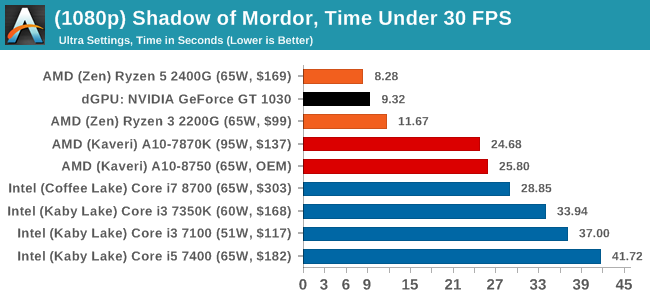
In Shadow of Mordor, the 2400G takes the top spot in average frame rates, but the GT 1030 just wins on percentiles. Over Kaveri, AMD is now offering double the graphics performance, and over Intel, AMD is easily 2-3x in performance per dollar.
Grand Theft Auto V
The highly anticipated iteration of the Grand Theft Auto franchise hit the shelves on April 14th 2015, with both AMD and NVIDIA in tow to help optimize the title. GTA doesn’t provide graphical presets, but opens up the options to users and extends the boundaries by pushing even the hardest systems to the limit using Rockstar’s Advanced Game Engine under DirectX 11. Whether the user is flying high in the mountains with long draw distances or dealing with assorted trash in the city, when cranked up to maximum it creates stunning visuals but hard work for both the CPU and the GPU.
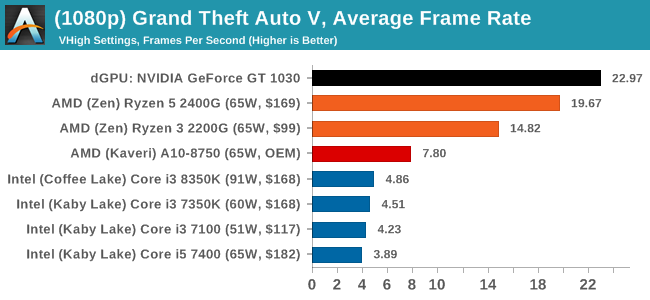
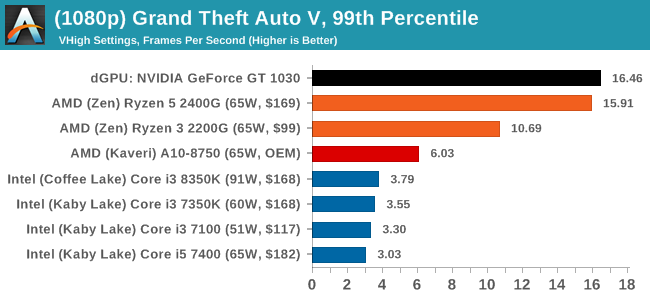

The difference between something playable and a slide show was easily noticable in GTA. The GT 1030 had the legs on this one, although the gap between the two AMD parts was mostly noticable in 99th percentile numbers.










177 Comments
View All Comments
speely - Monday, February 12, 2018 - link
"Where is the i5-8400 that has the same price as the 2400G?Oh, yeah, they totally left it out from the benchmarks since it would have proved an absolute supremacy of the Intel offering.
Ops."
In which benchmarks do you expect to see the i5-8400 prove its "absolute supremacy" where the i5-7400 didn't? Seriously, I'd like to know.
Because what I see is either the i5-7400 beating the 2400G or going punch to punch with it, or being thoroughly decimated by it.
If the i5-7400 beats or competes with the 2400G, the i5-8400 refresh chip will do the same. If the i5-7400 gets trounced by the 2400G, the i5-8400 refresh chip isn't suddenly and magically going to beat it.
I fail to see anything in the article to indicate a pro-AMD bias on AT's part, either intentional or unintentional.
What I do see is a fanboy who's upset to see his team losing some benchmarks.
Kamgusta - Monday, February 12, 2018 - link
Ehm sir, 7400 is 4 core and 8400 is 6 core.Other reviews shows a 30% performance dominance of i5-8400 over the 2400G.
speely - Monday, February 12, 2018 - link
Fair point, and my apologies. I keep forgetting that they upped the i5's to 6 cores after a decade of 4c4t i5's (including the 4690K I currently use).That being said, the i5-8400 itself is the same price as the 2400G, but getting the i5-8400 running is not the same price as getting the 2400G running. The 2400G was tested on an MSI B350I Pro AC (https://www.anandtech.com/show/12227/msi-releases-... which is new and doesn't yet have a publicly-known MSRP, but is built and featured like other $70-80 B350 motherboards. What motherboards are on the market today for $70-80 that support the i5-8400?
So we've taken into account the additional 2 cores and the subsequent boost to the CPU-focused benchmarks, which the 7400 sometimes lost and sometimes won against the 2400G, and put a couple small notches into the 8400's belt. For another 50 bucks or so on the motherboard just to use the 8400, that's not too bad I suppose. It's what I would expect pitting a 6c6t CPU against a 4c8t CPU in CPU benchmarks. It's certainly not "absolute supremacy" but it's something, right?
Were you expecting that "absolute supremacy" to show up in iGPU gaming? I'll just laugh about that and move on.
Sure, the 8400 could probably step past the 2400G in gaming and graphics if you paired it with a $120-or-so graphics card (assuming you can find one at $120 or so), but then you're comparing a dGPU to an iGPU and you're still only barely stepping past.
So the only real way to make the 8400 show "absolute supremacy" over the 2400G is to cherry-pick just the benchmarks you like, and bolster the 8400 with another $200 of additional hardware.
"Absolute supremacy".
Manch - Monday, February 12, 2018 - link
No it's not.In regards to vs the 8400, its a mixed bag. For programs that favor Intel CPU's there is a clear advantage. For programs that favor AMD the advantage swings the other way. For everything else that's generally proc agnostic they tie, pull ahead slightly or gets beat relatively evenly in regards to CPU performance.Now GPU wise, it gets crushed. That's obvious that is gonna happen.
If you plan on getting a DGPU with some beef, either is good, If you looking to game on the cheap, which is the target of the AMD proc in this review, its the hands down winner. Comparable perf, but with a beefier iGPU that can hang with a 1030. Also it gives you the option of adding a DGPU later when you need more grunt. It's clearly the better buy this go around. No other site that Ive seen has argued against this.
dromoxen - Tuesday, February 13, 2018 - link
Are these going to get a 12nm refresh , as all the other ryzen cpus? I am thinking of upgrade either i58400 or r5 1600/1700 or possibly 2400g.. decision decisions ...Manch - Wednesday, February 14, 2018 - link
Originally it was labeled as 12nm, now referred to 14nm+.Probably will be updated.cheshirster - Monday, February 12, 2018 - link
You need Z370 for the "supremacy" to work.Ops.
bug77 - Monday, February 12, 2018 - link
That will be fixed when lower tier 300-series chipsets launch. However, it's a significant problem for those wanting to build a cheap setup until then.Ian Cutress - Monday, February 12, 2018 - link
I used the chips I have on hand for the tests, forgot to add already tested chips - we haven't tested the i5-8400 IGP, but the CPU results are on hand in Bench. I can add those results to the graphs when I get a chance.Manch - Monday, February 12, 2018 - link
Ian, I dont know if fhis is just when browing from a phone but the bench when listing CPUs while alphabetic, bc of the chips names ~lake, etc. The listing jumps all over the place. 8 series before 4 seriez then 7 series. Can yall fix this? Thanks